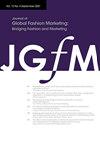影响消费者购买绿色化妆品决策过程的关键因素。系统的文献综述
IF 5.5
Q2 BUSINESS
引用次数: 0
摘要
摘要本文基于2007年至2022年的60项研究,首次尝试对影响消费者购买绿色化妆品决策过程的因素进行系统分类。以刺激-机体-反应(SOR)范式为理论框架对影响因素进行分类。SLR研究结果表明,消费者的决策过程主要受到社会心理刺激的驱动,如环境关注、健康意识和社会规范。这些刺激触发消费者的内部状态,包括认知状态和情感状态。内部状态由促进因素(如对绿色化妆品的态度、感知到的产品质量和产品知识)和抑制因素(如感知到的高价格、怀疑和绿色清洗)表示。在最后的回答中,购买意向在回顾的研究中被发现最多。在社会人口特征方面,绿色化妆品消费者的主要特征是妇女、就业人员、高教育水平和高收入。该研究还强调了现有文献的核心局限性,并提出了未来调查的研究议程。关键词:消费者行为可持续消费购买意向自然或理论致谢作者要感谢匿名审稿人的有益意见和对手稿的仔细阅读。披露声明作者未报告潜在的利益冲突。数据可用性声明支持本研究结果的数据可在Mendeley Data上公开获取http://doi.org/10.17632/cn2ddk982f.1.Author contributionsRiccardo Testa对研究的概念和设计做出了贡献,并撰写了原始草稿以及审查过的草稿。Giuseppina Rizzo与Riccardo Testa合作进行文献检索和数据分析。乔治·希法尼(Giorgio Schifani)参与撰写了初稿。József Tóth参与了调查过程。Giuseppina Migliore严格修改了这项工作并监督了这项研究。所有作者都阅读并批准了最终的手稿。本研究由意大利巴勒莫大学研究基金[FFR_2023]资助。本文章由计算机程序翻译,如有差异,请以英文原文为准。
Critical determinants influencing consumers’ decision-making process to buy green cosmetics. A systematic literature review
ABSTRACTThe current Systematic Literature Review (SLR) represents the first attempt to systematically classify the factors influencing consumers’ decision-making process to purchase green cosmetics, based on a review of 60 studies from 2007 to 2022. The factors were classified using the Stimulus-Organism-Response (SOR) paradigm as the theoretical framework. The findings of the SLR indicate that consumers’ decision-making process is primarily driven by socio-psychological stimuli, such as environmental concern, health consciousness, and social norms. These stimuli trigger internal states in consumers, which consist of cognitive and affective states. The internal states are represented by facilitators, such as attitude towards green cosmetics, perceived product quality, and product knowledge, as well as inhibitors, such as perceived high price, skepticism, and greenwashing. Among the final responses, purchase intention was found to be the most detected in the reviewed studies. Regarding socio-demographic characteristics, the segment of green cosmetic consumers is mainly characterized by women, employed individuals, with a high level of education and income. The study also highlights the core limitations of the existing literature and proposes a research agenda for future investigations.KEYWORDS: Consumer behavioursustainable consumptionpurchase intentionnaturalSOR theory AcknowledgementsThe authors would like to thank anonymous reviewers for their helpful comments and careful reading of the manuscript.Disclosure statementNo potential conflict of interest was reported by the author(s).Data availability statementThe data that support the findings of this study are openly available in Mendeley Data at http://doi.org/10.17632/cn2ddk982f.1.Author contributionsRiccardo Testa contributed to the study conception and design and wrote the original draft as well as the reviewed one. Giuseppina Rizzo worked with Riccardo Testa to perform the literature search and data analysis. Giorgio Schifani contributed to write the first draft. József Tóth contributed to the investigation process. Giuseppina Migliore critically revised the work and supervised the study. All authors read and approved the final manuscript.Additional informationFundingThis work was supported by Research Funding Fund [FFR_2023] funded by the University of Palermo, Italy.
求助全文
通过发布文献求助,成功后即可免费获取论文全文。
去求助
来源期刊

Journal of Global Fashion Marketing
BUSINESS-
CiteScore
6.90
自引率
31.60%
发文量
34
期刊介绍:
The Journal of Global Fashion Marketing is a quarterly journal that publishes peer-reviewed conceptual and empirical papers and business cases of original works that significantly contribute to the overall advancement of marketing theory, research, and practice in fashion, design, and culture. JGFM endeavors to be a “global bridge” connecting marketing scholars and practitioners in fashion, design, and culture throughout the world. We publish high-quality scholarly articles on marketing written by contributors representing the leading academic authors. As we state on the cover of every issue, our positioning statement, our value added to the marketing scholar readership, is truly to “Bridge Fashion and Marketing” 1. Monitor and analyze global fashion marketing trends. 2. Generate and integrate new ideas and theories related to fashion, luxury, and culture marketing theory and practice. 3. Apply new research methods and techniques in fashion, luxury, and culture marketing. 4. Explore and disseminate cutting edge fashion marketing practices. JGFM welcomes manuscripts that provide fresh, innovative insight to any topic in the field of fashion, luxury, and culture marketing. Both conceptual and empirical works are valued, so long as the manuscript addresses substantive issues in marketing.
 求助内容:
求助内容: 应助结果提醒方式:
应助结果提醒方式:


